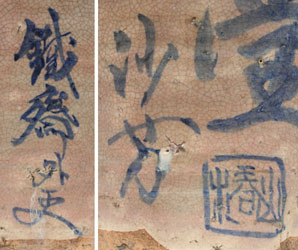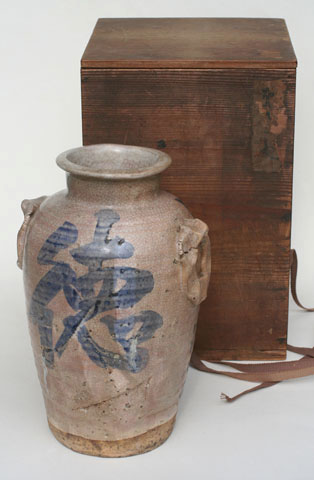zenga
Tsubo, pot- Toku, virtue, Kakikumandô, Hall full of beautiful ChrysanthemumsSigned: Tessai Gaishi & Sahô (Sunayoshi)
Seals: Unread
Technique: Brown wheel turned Kyoyaki, with a raw craqueled glaze and with a blue tetsu-e underglaze calligaphy Ø 15,5 (17) x 26
Condition: Very good
Tessai was born in Kyoto into a family selling robes and accessories for the Buddhist clergy. As a result of a childhood illness he became partly deaf. It was therefore considered improbable that he would ever become a successful shopkeeper. Instead he went to study the Japanese classics in order to become a Shinto priest. He also did Chinese studies, specializing in the teachings of the neo-confucianist Wang Yang-Ming. Later he would study Buddhism, literature and Shingaku, a semi-religious system for self-cultivation. As a youth he met Ōtagaki Rengetsu and became her special protégé. She taught him waka and encouraged his artistic inclinations. In the final years of the Tokugawa era Tessai was involved in the pro-imperialist movement. to escape the bakufu for sympathizing with the restoration movement he left Kyoto and travelled to Nagasaki in 1859. Here he started to study Nanga painting. Nagasaki was the first of many trips; Tessai became and avid traveller. In 1882 he settled in Kyoto where he spent the rest of his life. Although he worked as a priest at several Shinto shrines, he saw painting as his chief occupation. Together with Tanomura Chokunyū (1814-1907) Tessai was also a important promoter of tea ceremony with his book, ‘Tetsusô chafu’, Tessai’s tea records, a 2 volume set published in 1867, and the production of tea ceramics. Between 1894 and 1904 he was a teacher at the Kyoto Prefectural Art School founded by Chokunyū. He was a regular contributor to exhibitions of Chokunyū’s Nanga Society. In 1917 he was appointed Artist to the Imperial Household and towards the end of his life he received an honorary court-rank. Tessai is often seen as the last great exponent of the Nanga school.
Some Reference:
H. Kanazawa & Willy vd Walle; Tomioka Tessai (1836-1924), Leuven 1989
Ruiko Kato: Tessai and His Teachers and Friends, Kyoto 1997
Aichi prefectural Museum: Tomioka Tessai Retrospectiv,e Aichi 1996
Patricia,J. Graham: Tea of the sages: The Art of Sencha, Honolulu 1998
Price: ON REQUEST

